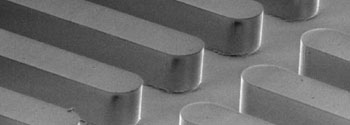Intracameral Implants Promote Ocular Therapeutics
By HospiMedica International staff writers
Posted on 27 May 2015
Novel particle replication in non-wetting templates (PRINT) technology can be used to deliver therapeutic molecules for treating various eye diseases.Posted on 27 May 2015
The Envisia ENV515 implant is a proprietary, fully biodegradable particle formulation of travoprost—a prostaglandin analog—with the potential for sustained intraocular pressure (IOP) reduction in both the anterior and posterior chamber of the eye over a period as long as six months, thus providing a method that could potentially address the poor medication compliance rates that exist among glaucoma patients. The product is currently undergoing an open-label first-time-in-human phase 2a clinical study that enrolled 20 glaucoma patients at various sites.

Image: ENV515 particles fabricated with PRINT technology (Photo courtesy of Envisia Therapeutics).
PRINT technology engineers precise particles of virtually any size, shape, and chemistry, including small molecule active pharmaceutical ingredients (API), biologic APIs, and polymeric drug delivery systems. Using biocompatible polymers and extended-release kinetics, the technology can be used to fabricate biodegradable particle implants for placement in the eye to optimize cellular uptake, intracellular localization, surface deposition, and many other performance parameters. ENV515 is under development by Envisia Therapeutics (Research Triangle Park, NC, USA).
“Poor patient compliance has long been a significant challenge in the treatment of glaucoma, making it a leading cause of preventable blindness in the United States today,” said Steven Mansberger, MD, MPH, lead investigator for the ENV515 trial and director of glaucoma services at the Devers Eye Institute (Portland, OR, USA). “Investigational products such as ENV515 have the potential to transform the treatment of glaucoma by removing compliance barriers and providing sustained reduction of intraocular pressure.”
“We are excited to advance ENV515 into clinical development only a year after forming the company, an accomplishment we are very proud of,” said Neal Fowler, CEO of Envisia. “The progress made with ENV515 underscores the power and flexibility of the PRINT technology to rapidly develop and advance promising product candidates, simultaneously, across multiple areas of interest in ophthalmology.”
Glaucoma is not curable and once there is vision loss, it cannot be regained. With an early diagnosis and effective medication it is possible to stop further loss of vision, but patient adherence to the medication is a constant challenge, and is recognized as an essential component to treatment. Several factors, including difficulty of self-administering or remembering to administer eye-drops, inconvenient or frequent dosing, and unpleasant side effects have been identified as contributing to poor glaucoma patient pharmacotherapy.
Related Links:
Envisia Therapeutics













.jpg)
